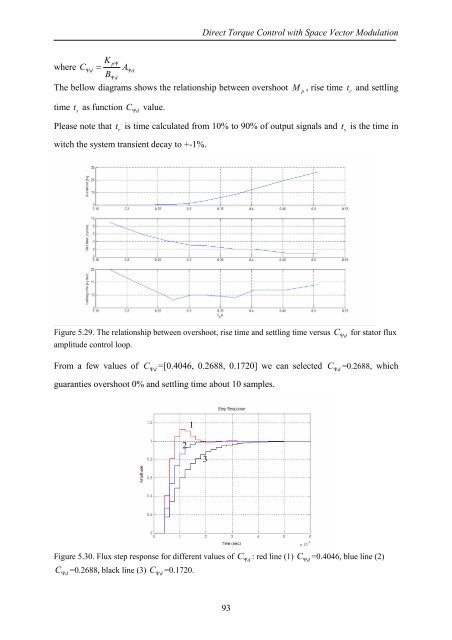Direct Torque Control with Space Vector Modulation (DTC-SVM) of ...
Direct Torque Control with Space Vector Modulation (DTC-SVM) of ...
Direct Torque Control with Space Vector Modulation (DTC-SVM) of ...
You also want an ePaper? Increase the reach of your titles
YUMPU automatically turns print PDFs into web optimized ePapers that Google loves.
<strong>Direct</strong> <strong>Torque</strong> <strong>Control</strong> <strong>with</strong> <strong>Space</strong> <strong>Vector</strong> <strong>Modulation</strong><br />
K<br />
pΨ<br />
where CΨd<br />
= AΨd<br />
BΨd<br />
The bellow diagrams shows the relationship between overshoot<br />
time t s<br />
as function<br />
C Ψ d<br />
value.<br />
M<br />
p<br />
, rise time t r<br />
and settling<br />
Please note that t r<br />
is time calculated from 10% to 90% <strong>of</strong> output signals and t s<br />
is the time in<br />
witch the system transient decay to +-1%.<br />
Figure 5.29. The relationship between overshoot, rise time and settling time versus<br />
amplitude control loop.<br />
From a few values <strong>of</strong><br />
C Ψ d<br />
=[0.4046, 0.2688, 0.1720] we can selected C Ψ d<br />
guaranties overshoot 0% and settling time about 10 samples.<br />
C Ψ d<br />
for stator flux<br />
=0.2688, which<br />
1<br />
2<br />
3<br />
Figure 5.30. Flux step response for different values <strong>of</strong><br />
C Ψ d<br />
=0.2688, black line (3) C Ψ d<br />
=0.1720.<br />
C Ψ d<br />
: red line (1) C Ψ d<br />
=0.4046, blue line (2)<br />
93















![[TCP] Opis układu - Instytut Sterowania i Elektroniki Przemysłowej ...](https://img.yumpu.com/23535443/1/184x260/tcp-opis-ukladu-instytut-sterowania-i-elektroniki-przemyslowej-.jpg?quality=85)
